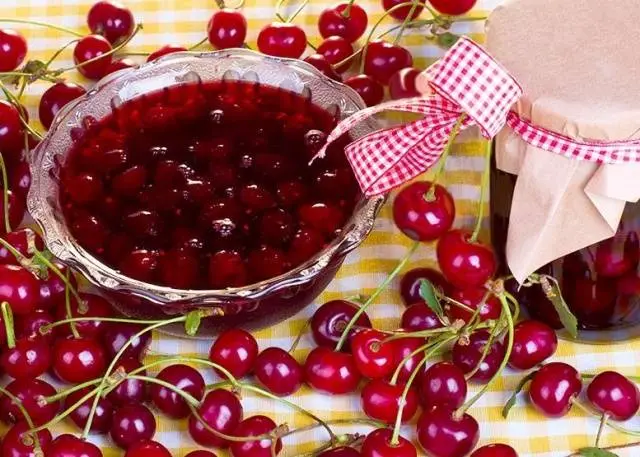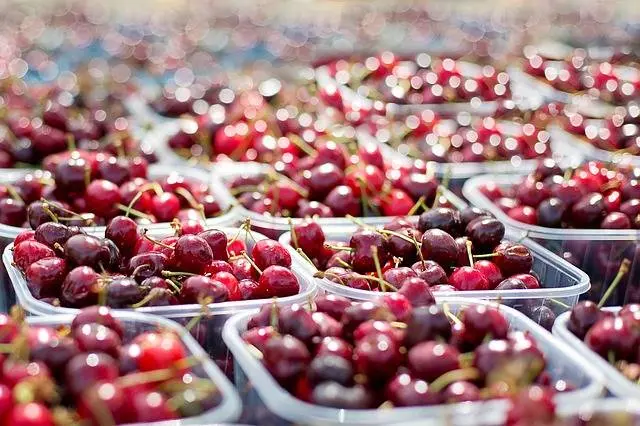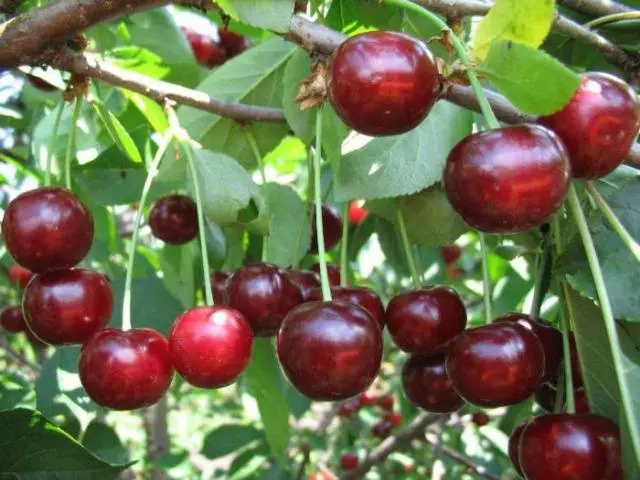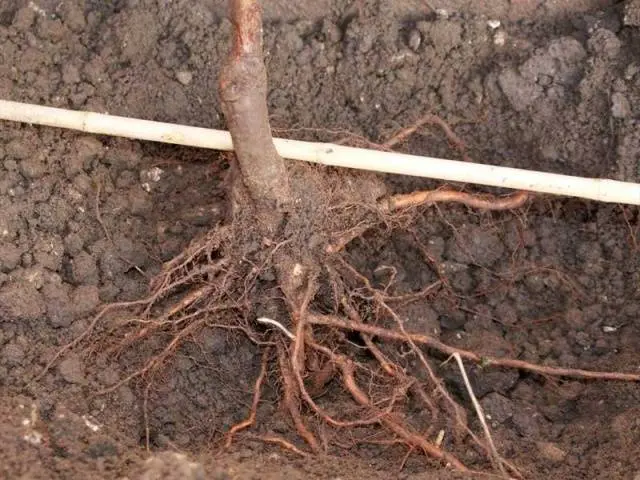Contents
Now low fruit trees are especially in demand. Cherry Saratovskaya Malyshka is a relatively new variety that is not very tall. It is easy to care for and harvest berries, so crop losses are minimized. If we add to this the good taste of the fruit and early ripening, then the love for the Saratovskaya Baby variety of gardeners, especially owners of small plots, becomes clear.

History of breeding
Cherry Saratovskaya Malyshka is often called simply Malyshka. This variety cannot be called the newest – it was created in 1995 by the Saratov Experimental Horticulture Station. The authors are G. I. Dymnova, A. P. Kruglova and E. E. Kaverin. The Saratov cherry variety Malyshka was obtained by crossing the Early griot and Duke 1-2-29.
Description of the culture
Cherry Duke Malyshka has absorbed the best features of the parent varieties. It grows as a medium spreading tree with a dense spherical crown. And although you can’t call Baby dwarf cherry – the height of the trunk reaches 2-2,5 m, it looks neat and compact.

Thick, smooth branches with brown bark are arched, becoming bare with age. Numerous lenticels on the shoots are clearly visible, they are large, yellowish, with a white border. The large dark green leaves of the Saratov Baby are obovate, serrate at the edges, with a sharp tip and base. The plate is concave, the petiole is medium in size, red at the base.
The flowers are white, large, appear on the bouquet twigs. Most often they are single or collected in 3 pieces. After ripening, a beautiful large cherry is formed. In the Saratovskaya Malyshka variety, it reaches an average of 5 g, but with good agricultural technology and favorable weather conditions, it can gain 7-8 g.

The appearance of the fruit is rated 5 points. The one-dimensional berries of the Saratov Malyshka are rounded, slightly flattened from the side of the stem, with a slight depression. The top of the fruit is slightly flattened. The abdominal suture is expressed moderately, subcutaneous points are absent. The pulp, juice and surface of the cherry are dark red. The berry contains a lot of juice, its sweet and sour dessert taste is rated at 4,4 points.

The stem is securely attached to the branches. Fruit holding strength is medium. The smooth ovoid bone is well separated from the pulp, its weight is about 0,4 g.
Cherry-cherry hybrid Malyshka is recommended for cultivation in the Lower Volga region. But due to its resistance to growing conditions and adverse weather factors, the variety is common in all Central regions of Our Country.
Features
The characteristics of Malyshka cherry make it indispensable for small private gardens located in central Our Country. This cultivar has been grown in home gardens for more than 20 years, and has earned excellent reviews.
Drought resistance, winter resistance
The drought resistance of the Saratovskaya Malyshka variety is good, an adult tree needs to be watered only with a long absence of rain. In the Lower Volga region, this cherry has excellent resistance to cold. Even in harsh winters, neither wood nor flower buds freeze.

Pollination, flowering period and ripening period
Cherry Saratovskaya Baby in Central Our Country blooms in mid-May. Harvesting begins on the twentieth of June. If the spring was late, flowering and fruiting are shifted to a later date.

Variety Baby – one of the earliest. But it should be remembered that this cherry is self-fertile. This means that without pollinators, it will give only 5% of the possible yield. If you want to get a lot of berries, you should have other cherries with similar flowering periods within a radius of 40 m. The best pollinators for the Malyshka variety are Lyubskaya, Turgenevka, Nord Star.
yield, fruiting
Cherry Saratovskaya Malyshka grows rapidly and begins to produce crops after planting for 3-4 years. When testing the variety, an average yield of 14,6 kg from an adult tree was indicated. But with good care and favorable weather, this figure increases to 20-25 kg. Conditions also affect the size of the fruit. With an average of 5 g in a good year, one berry can weigh 7-8 g.
Scope of berries

Cherry Saratovskaya Malyshka – table variety. This means that it is primarily recommended for fresh consumption. Attractive large berries obtained from crossing a duca with a griot will decorate any table. From cherries, Malyshka took an excellent sweet taste, from griot – juicy red flesh.
This cherry is also good in preparations. First of all, juice and compotes are made from it – they have a good taste and attractive color. Other processed products include jams and jams. Desserts with cherries Saratovskaya Malyshka are especially good.
Thanks to its dense pulp, good taste and high transportability, this variety can be used as a commercial variety.

Disease and pest resistance
Variety Saratovskaya Malyshka is moderately resistant to typical diseases and pests of cherries. Coccomycosis and moniliosis are severely affected only during the years of epizootics.
Thanks to its compact, dense crown, the Malyshka cherry suffers little from birds.
Advantages and disadvantages
Variety Saratovskaya Malyshka showed itself best when grown in the Nizhnevolzhsky and Central regions. In other areas, it is also planted, but there it gives a smaller harvest and gets sick more often. The advantages of the Baby include:
- High productivity.
- Good drought tolerance.
- Attractive appearance and good taste of berries.
- High frost resistance of stem, flower buds and wood.
- Early ripening.
- The versatility of the use of fruits.
- Good transportability of berries.
- Compact size for easy harvesting.

The disadvantages of the Saratov Baby can be considered:
- Insufficiently strong attachment of berries to the stalk.
- In the northern regions, cherries may freeze slightly. In particular, early blooming flowers can be subject to return frosts.
- Insufficient resistance (medium) to coccomycosis.
- Self-infertility of the variety.
Features of landing
Cherry Saratovskaya Malyshka does not impose any special requirements that are different from other varieties. The main thing here is to follow the rules for planting and placing a seedling on the site.
Recommended dates
Cherry Baby is best planted in early spring, before bud break. This is especially important for this variety, as it blooms in mid-May. So planting pits are recommended to be prepared in the fall. If the seedling was purchased at the end of the year, it is recommended to dig it in the area, and in the spring move it to a permanent place.
In the southern regions, it is better to plant cherries after leaf fall. Late frosts will allow the plant to take root before the onset of cold weather. In addition, in the south, spring has recently been quickly replaced by heat – the seedling will suffer from heat if placed on the site in spring.

Choosing the right place
The best place for cherries will be a sunny place on a small hill with a gentle slope. If strong winds blow in the region, you should plant the crop under the protection of other trees or buildings. The main thing is that the cherry has enough sunlight. Groundwater should be no closer than 2 m to the surface.
The soil needs a neutral, loose, with a lot of organic matter. Acidic soil needs to be improved with dolomite flour, chalk or lime. Dense soils are made permeable by introducing sand and a large amount of humus.
What crops can and cannot be planted next to cherries
Since Malyshka is self-fertile, the best neighbors for her will be pollinating cherries of the Lyubskaya, Nord Star or Turgenevka varieties. You can plant other stone fruit crops nearby. Cherry does not like the neighborhood of walnut, oak, maple, birch.

The close location of beds with nightshade crops – potatoes, tomatoes, peppers will increase the likelihood of Baby being infected with fungal diseases. With raspberries, sea buckthorn and other shrubs with rapidly expanding roots, cherries will compete for moisture and nutrition.
After the culture is well rooted and begins to produce a crop, the near-stem circle can be planted with small ground cover plants. They will retain moisture and cover the cherry root from overheating in the hot summer.
Selection and preparation of planting material
The demand for low-growing cherries is great. Therefore, it is best to buy the Saratov Baby directly from a nursery or a reliable garden center that values uXNUMXbuXNUMXbits reputation.
When choosing a seedling, you need to pay attention to:
- on the root system: it must be well developed and intact;
- to the height of the trunk – optimal for one-year-old cherries – 80-90 cm, two-year-olds – no more than 110 cm;
- the bark of the Saratov Baby should be brown and smooth, the twigs should be elastic.
Container plants should be watered before planting, and cherries with an open root system should be soaked for at least 3 hours.
Landing algorithm
The landing pit must be prepared in advance. Standard size: width – about 80 cm, depth – not less than 40 cm. When digging a hole, the upper, fertile layer of the earth is set aside and mixed with a bucket of humus, potash and phosphorus fertilizers (50 g each). If necessary, add sand and soil deoxidizer (lime, dolomite flour). Then they act according to the following scheme:
- Slightly away from the center of the pit, a strong peg is driven in.
- Cherry seedling set in the middle.
- The root is gradually covered with fertile soil, constantly compacting it.
- The stem is tied to a peg.
- The root neck is left to rise above the soil surface by 5-8 cm.
- An earthen roller is poured around the trunk circle.
- A young tree is watered with 2-3 buckets of water.

Culture aftercare
In the first season after planting cherries, you need to regularly water it, loosen the trunk circle and weed out. When the tree takes root, moisten the soil only with a long absence of precipitation. In the fall, be sure to do moisture charging.
Loosening the soil under the cherry is necessary only in the first years. Then the near-trunk circle is filled with ground covers growing in the region that can withstand the shade.
The best top dressing for cherries is cow dung and ash. They are brought under the root in the fall. If you use mineral fertilizers, you need to remember that the culture needs a lot of nitrogen and potassium, but phosphorus should be limited (but not completely eliminated).
Cherries need to be pruned regularly. This will avoid many diseases and increase the yield. Variety Saratovskaya Malyshka tends to expose old branches. Pruning contributes to the development of new shoots and the formation of a large number of bouquet branches, on which cherries are formed.

For the winter, there is no need to cover this cherry in the regions recommended for cultivation. The culture is saved from hares and other rodents by wrapping the bole with spruce branches or burlap, or by installing a protective net.
Diseases and pests, methods of control and prevention
Variety Saratovskaya Malyshka is moderately resistant to fungal diseases. From them, this cherry suffers greatly only during the years of epizootics. Prevention and control measures for the most common are given in the table. Other diseases will be discussed in another article.
Problem | Evidence | Treatment | Prevention |
Kokkomikoz | First, dark spots appear on the leaves, then they turn into holes. On the back, a plaque forms. In the middle of the season, diseased leaves will fall off. Brown spots with a whitish coating appear on the fruits | Treat with appropriate fungicides as directed. Good results are obtained by spraying with preparations containing copper. | Regular pruning to avoid thickening of the crown and the spread of the disease. Preventive spraying with copper-containing preparations on a green cone and iron sulfate after leaf fall. In autumn, under a tree, all plant residues are collected and burned. |
Moniliasis | The tree looks affected by the heat. First, leaves, flowers or berries die, then whole branches die off. | Diseased vegetative organs are removed, capturing about 10 cm of healthy tissue. The wound surface is first treated with a copper-containing preparation, then with garden pitch. The tree is sprayed with an appropriate fungicide | As for coccomycosis |

Variety Saratovskaya Malyshka combines the genes of cherries and sweet cherries. Of the pests, it is most often affected by aphids. If there are few insects, they fight them with folk remedies, for example, with a solution of laundry soap. In case of severe damage, cherries are treated with insecticides.
General prevention from pests is the same as for coccomycosis. In the spring, 10 days after treatment with a copper-containing preparation, spraying with a systemic insecticide is carried out.
Harvesting and recycling
It must be remembered that cherries do not ripen during storage. In relation to this culture, the term “technical maturity” does not make sense. If the berries are to be transported, harvesting must not be delayed.

Cherries should be picked as soon as they are ripe. Otherwise, it will become the prey of birds, and the berries of the Saratovskaya Malyshka variety may fall to the ground, since their attachment to the stalk is average. In addition, it is in overripe fruits that all sorts of larvae and small caterpillars like to settle.
The sooner you process the crop, the more nutrients it will retain. Fresh cherries of the Malyshka variety can be stored in the refrigerator for 6-7 days.
Conclusion
Cherry Saratovskaya Malyshka is a beautiful compact tree. Its fruits ripen early, have a good taste and attractive appearance. The variety is excellent for growing in small areas.
Reviews










